Dry Vs Wet Measuring Cups
Dry and wet measuring cups serve distinct purposes in the kitchen. You'll use dry cups for ingredients like flour and sugar, while wet cups are for liquids like water and oil. Dry cups have flat tops for leveling off ingredients, whereas wet cups feature spouts and clear markings for easy pouring and reading. It's essential to use the right type for accurate measurements, as they're not interchangeable. Dry cups are typically made of opaque materials and come in smaller increments, while wet cups are clear and often larger. Using the correct measuring cup guarantees recipe success by providing precise ingredient amounts. Understanding these differences will greatly improve your culinary results.
This post may contain affiliate links. If you make a purchase through these links, I may earn a commission at no additional cost to you. Additionally, portions of this post may be generated using artificial intelligence (AI) technology. While we strive for accuracy, please be aware that AI-generated content may not always be perfect and should be fact-checked when necessary.
The Spatula Scoops
- Dry measuring cups are for solid ingredients, while liquid measuring cups are designed for fluids.
- Dry cups have flat tops for leveling, whereas liquid cups have spouts and curved edges for easy pouring.
- Dry cups are typically opaque and come in smaller increments; liquid cups are clear with graduated markings.
- Using the correct type of measuring cup ensures accurate measurements, crucial for recipe success.
- Dry ingredients are leveled off at the top, while liquids are measured at the bottom of the meniscus.
Understanding Dry Measuring Cups
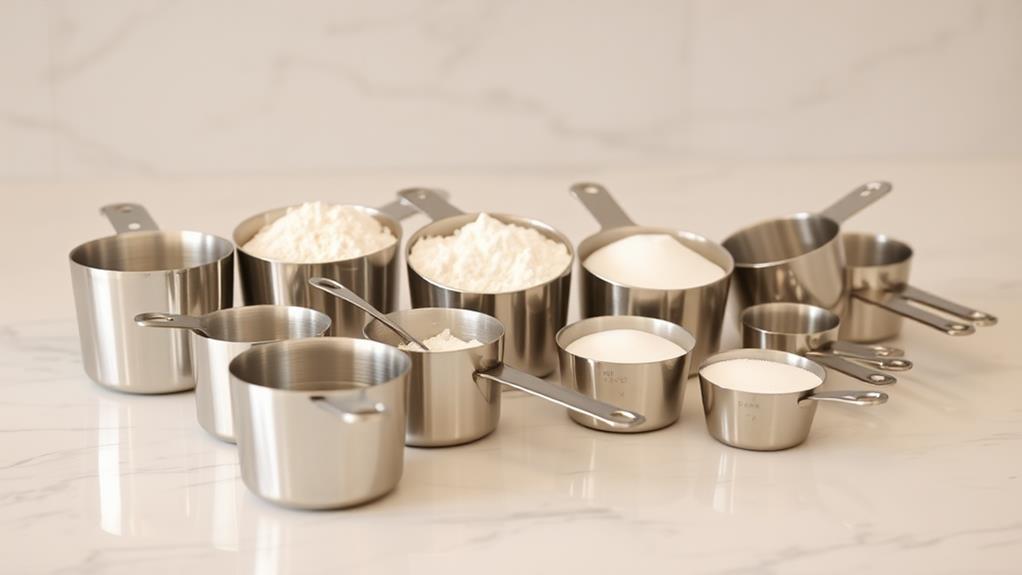
In the kitchen, precision is key, and dry measuring cups are the unsung heroes of accurate baking. These specialized tools are designed specifically for measuring dry ingredients like all-purpose flour, sugar, and nuts. You'll find them in standard sizes, typically including 1 cup, ½ cup, and ¼ cup measurements, allowing you to achieve the exact proportions your recipes require.
When using dry measuring cups, it's vital to level off the ingredients with a flat edge after filling. This guarantees you're not accidentally adding excess amounts, which could throw off your recipe. Unlike their liquid counterparts, dry measuring cups don't have spouts or graduated markings, making them unsuitable for measuring liquids.
You'll notice that dry measuring cups are usually made of durable materials like metal or plastic. This construction allows them to withstand frequent use and easily handle various dry substances. Remember, accuracy is paramount when measuring dry ingredients. By using the appropriate cup size and leveling off properly, you'll consistently achieve the precise measurements needed for successful baking. Whether you're a novice baker or a seasoned pro, mastering the use of dry measuring cups is essential for creating delicious, perfectly balanced recipes.
Exploring Liquid Measuring Cups
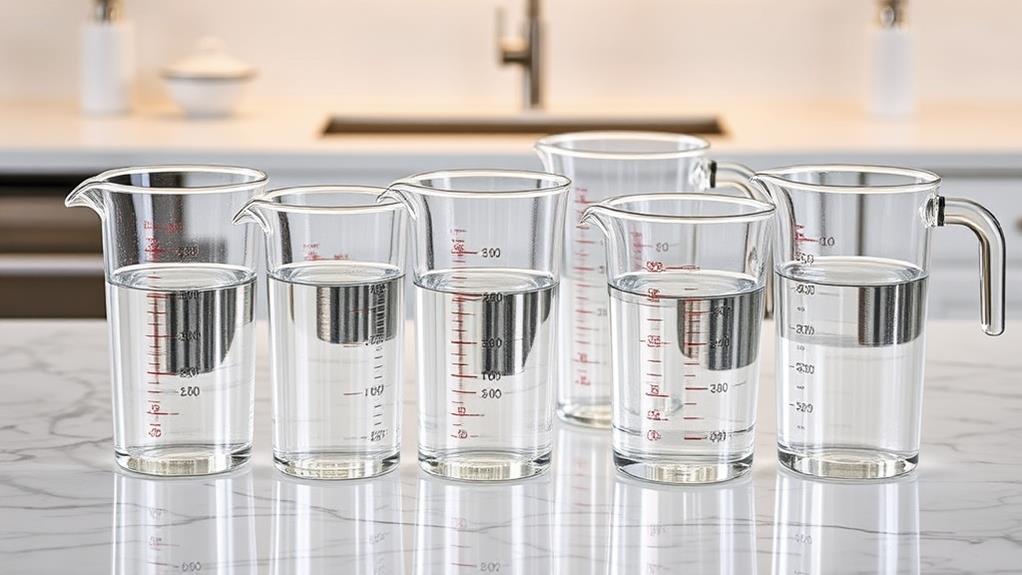
While dry measuring cups are indispensable for solid ingredients, liquid measuring cups play an equally important role in the kitchen. You'll find these versatile tools made of glass or clear plastic, designed with graduated measurement lines for precise volume measurements. When you're ready to measure liquids, you'll appreciate the spouts for pouring that help prevent messy spills.
To get an accurate reading, it's essential to fill the cup to the bottom of the meniscus, the curved surface of the liquid. This technique guarantees you're measuring the exact amount needed for your recipe. Liquid measuring cups come in various sizes, typically ranging from 1 to 8 cups, allowing you to measure different quantities with ease.
You'll find these cups ideal for measuring a wide range of liquid ingredients, including water, broth, oil, milk, honey, and corn syrup. The clear material and graduated lines make it simple to see exactly how much liquid you're working with. By using the right tool for the job, you'll improve your cooking accuracy and achieve more consistent results in your culinary endeavors.
Key Differences Between Measuring Types
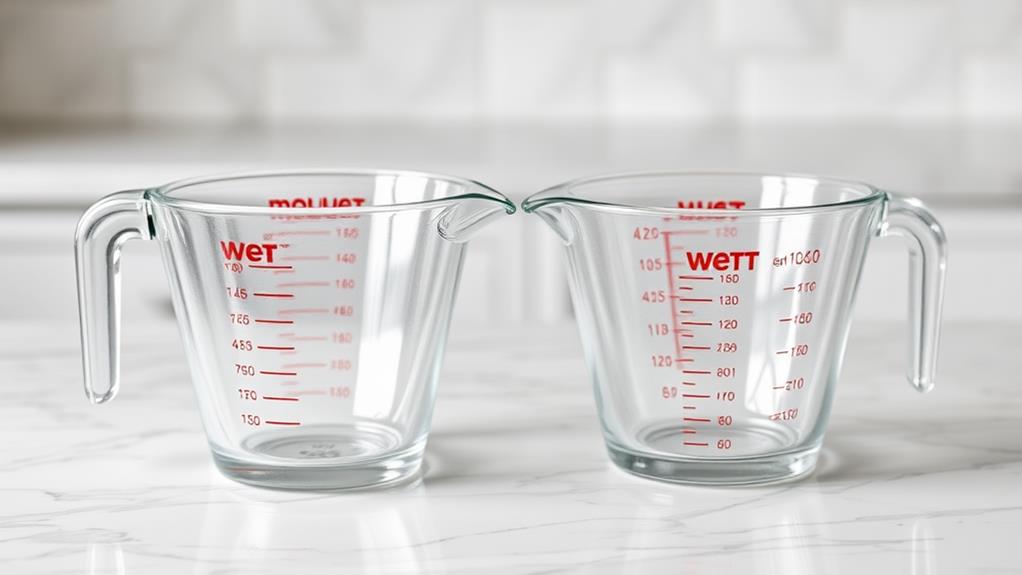
When comparing dry and liquid measuring cups, you'll notice significant differences in their design and construction. These variations directly relate to their intended ingredient applications, with dry cups optimized for solids and liquid cups for fluids. Understanding these distinctions is essential for measurement accuracy, as using the wrong type can lead to imprecise results in your cooking or baking.
Design and Construction Variations
For years, kitchen enthusiasts have recognized the distinct design and construction differences between dry and liquid measuring cups. These variations are essential for ensuring accurate measurement in your culinary endeavors. Let's explore the key design elements that set these types of measuring cups apart:
| Feature | Dry Measuring Cups | Liquid Measuring Cups |
|---|---|---|
| Material | Opaque (metal/plastic) | Clear (glass/plastic) |
| Top Edge | Flat for leveling | Curved with spout |
| Markings | Embossed/printed | Graduated lines |
| Sizes | 1/4 cup to 2 cups | Up to 8 cups |
Dry measuring cups are designed with a flat top, allowing you to level off ingredients for precise measurements. They're typically made of opaque materials, which prevent settling or packing of dry ingredients. On the other hand, liquid measuring cups feature a spout for easy pouring and clear construction that lets you see the liquid's meniscus for accurate readings.
The size ranges also differ between these two types. While dry cups usually come in smaller increments, liquid cups often have larger capacities. By understanding these design and construction variations, you'll be better equipped to choose the right tool for your measuring needs, ensuring your recipes turn out just right.
Intended Ingredient Applications
Dry and liquid measuring cups serve distinct purposes in the kitchen, each tailored to specific ingredient types. When you're measuring ingredients, it's essential to use the right tool for the job. Dry measuring cups are designed for solid ingredients like flour, sugar, and nuts. You'll fill these cups to the brim and level them off with a straight edge for accuracy. On the other hand, liquid measuring cups are meant for wet ingredients such as water, oil, and milk.
Here's why using the correct cup type matters:
- Accuracy: Dry cups guarantee precise measurements for baking, while liquid cups allow you to read the meniscus for fluids.
- Convenience: Liquid cups have spouts for easy pouring, whereas dry cups are stackable for storage.
- Capacity: Dry cups typically come in smaller sizes, while liquid cups often hold larger volumes.
Using the wrong cup can lead to measurement errors. If you use a dry measuring cup for wet ingredients, you might spill or misread the amount. Conversely, using a liquid cup for dry ingredients like flour can result in overpacking and inaccurate measurements. Always choose the appropriate cup to guarantee your recipes turn out perfectly.
Measurement Accuracy Considerations
Understanding the key differences between dry and liquid measuring cups is vital for achieving accurate measurements in your cooking and baking. When it comes to dry vs. liquid ingredients, the type of measuring cup you use can greatly impact your recipe's outcome. Dry measuring cups are designed for precise leveling of solid ingredients, while liquid measuring cups allow you to read measurements at the meniscus level for liquids.
To guarantee accuracy, you'll want to use dry measuring cups for ingredients like flour, sugar, and spices. Scoop the ingredient into the cup and level it off with a straight edge. For liquid ingredients, use a liquid measuring cup and place it on a flat surface. Bend down to read the measurement at eye level, taking into account the curvature of the meniscus.
Using the wrong type of measuring cup can lead to inaccurate measurements. If you use a dry measuring cup for liquids, you risk spills and imprecise amounts. Conversely, using a liquid measuring cup for dry ingredients can result in packed contents and excess material. Remember, accuracy is vital in baking, where even small measurement errors can greatly affect your results.
Common Measurement Mistakes to Avoid
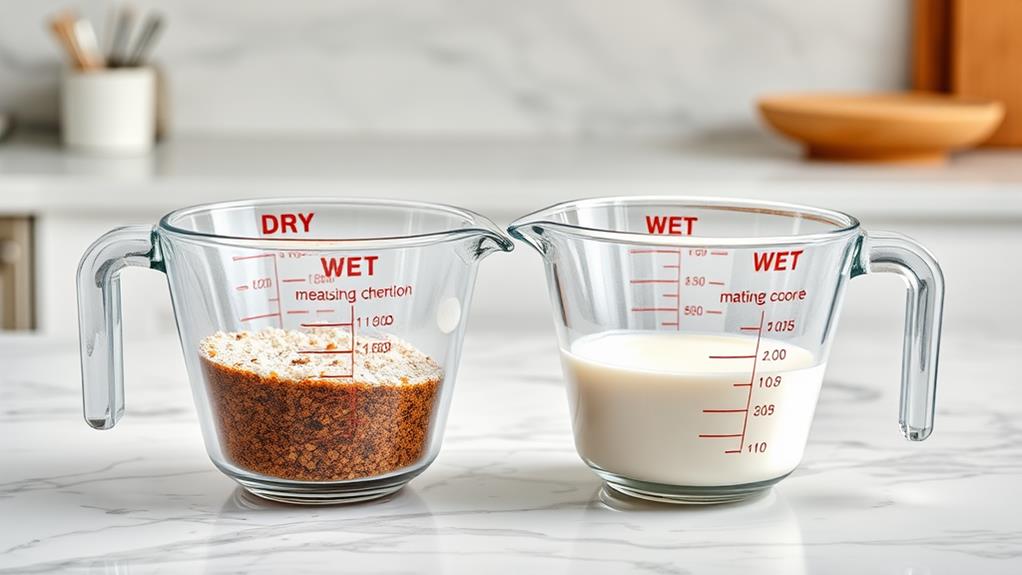
Accurate measuring is essential for successful cooking and baking, yet many home chefs make common mistakes that can throw off their recipes. When it comes to dry and wet measuring, it's vital to understand the difference between dry and liquid measuring cups. Using a liquid measuring cup for dry ingredients can lead to inaccurate measurements, as flour may become packed, resulting in excess amounts. Similarly, failing to level off dry ingredients with a flat edge can skew your recipe.
To avoid common measuring mistakes, keep these tips in mind:
- Use the appropriate measuring cup for the ingredient type (dry or wet).
- Level off dry ingredients with a straight edge for precise measurements.
- Read liquid measurements at eye level to avoid parallax errors.
When measuring ingredients, it's essential to recognize that dry and wet measurements aren't interchangeable by volume. One cup of flour weighs markedly less than one cup of water, which can greatly impact your recipe's outcome. By understanding these differences and using the correct measuring cup to measure each ingredient type, you'll improve your cooking and baking results considerably.
Choosing the Right Measuring Cup

When choosing the right measuring cup, you'll need to understand the key differences between dry and wet cups. The material and design of each type matter, with dry cups often made of metal or plastic for scooping and leveling, while liquid cups are typically clear glass or plastic with spouts for easy pouring. Your accuracy in selecting and using the appropriate cup directly impacts your recipe success, ensuring consistent results in your cooking and baking endeavors.
Understanding Cup Differences
Choosing the right measuring cup is vital for recipe success. You'll find two main types: dry measuring cups and liquid measuring cups. The difference between these tools is essential for accurate measurements. When measuring dry ingredients, you'll want to use dry measuring cups. These are designed to be filled to the top and leveled off with a straight edge. On the other hand, liquid measuring cups are perfect for measuring fluids, featuring a spout for easy pouring and allowing you to view the meniscus at eye level for precision.
Understanding these cup differences will help you achieve better cooking and baking results. Here's why it matters:
- Accuracy: Using the wrong type can lead to inaccurate measurements.
- Texture: Proper measurements impact the final texture of your dish.
- Flavor: Incorrect proportions can alter the taste of your recipe.
Standard sizes for liquid measuring cups typically range from 1 to 8 cups, while dry measuring cups come in smaller increments like 1/4, 1/2, and 1 cup. By maintaining the distinction between dry and liquid measuring cups, you'll guarantee that each ingredient is measured correctly, leading to more consistent and delicious results in your culinary endeavors.
Material and Design Matters
The materials and designs of measuring cups play an essential role in their functionality and accuracy. When you're cooking or baking, it's vital to understand the differences between dry measuring cups and liquid measuring cups. Dry measuring cups are typically made of opaque materials like plastic or metal, designed for durability and easy leveling of ingredients. They feature a flat top edge, allowing you to precisely measure dry ingredients like flour and sugar.
In contrast, liquid measuring cups are often made of clear glass or plastic, enabling you to see liquid levels easily. They have a taller profile to accommodate the meniscus curve of liquids and include a spout for easy pouring. The graduated measurement lines on liquid cups guarantee accurate measurements of various volumes.
Choosing the right measuring cup is essential for maintaining recipe integrity. Using a dry cup for liquids could lead to spillage, while using a liquid cup for dry ingredients might result in inaccurate, packed measurements. By familiarizing yourself with the materials and designs of measuring cups, you'll be better equipped to achieve consistent results in your culinary endeavors.
Accuracy in Recipe Success
In accordance with the goal of recipe success, selecting the right measuring cup is paramount. Accuracy in measurement is essential, especially when you're baking. Using dry measuring cups for solids and liquid measuring cups for fluids guarantees precision in your recipes. When you measure flour with a dry cup, you'll level it off with a straight edge for an exact amount. For liquids, you'll use a cup with a spout and measure at eye level, noting the meniscus for accuracy.
To enhance your measuring precision:
- Invest in both dry and liquid measuring cups
- Consider using a digital scale for even greater exactness
- Practice proper techniques for each type of measurement
Understanding the differences between these measuring cups will greatly improve your cooking results. Liquid measuring cups allow for easy pouring and precise volume measurement, while dry measuring cups are designed for ingredients you can level off. By using the appropriate cup for each ingredient, you're setting yourself up for consistent, successful outcomes in your culinary endeavors. Remember, even small measurement discrepancies can affect your final product, so take the time to measure accurately every time you cook or bake.
Precision in Baking and Cooking
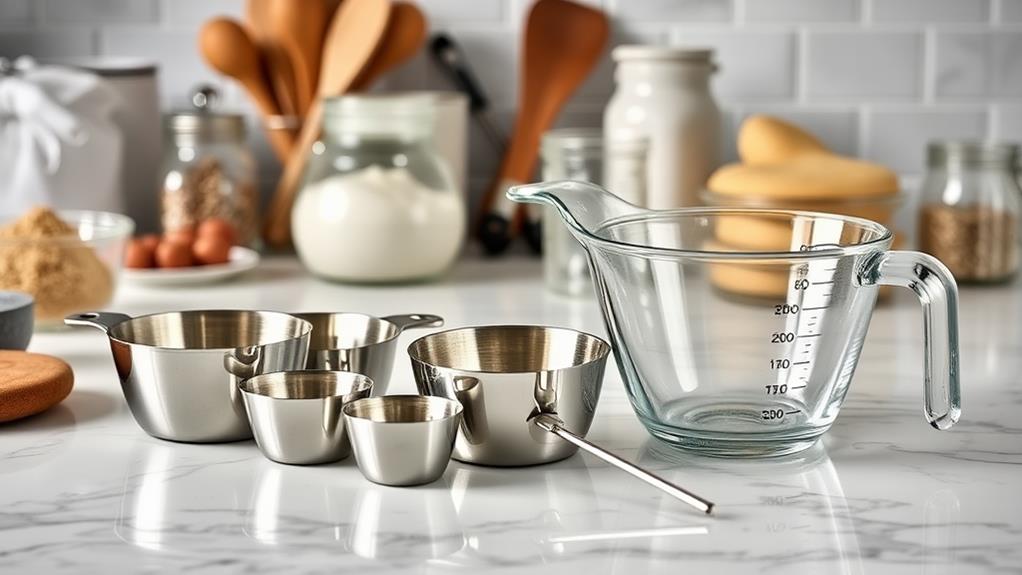
When it comes to baking and cooking, precision is paramount. You'll find that accurate measurement is essential for achieving the perfect texture and flavor in your baked goods. This precision relies heavily on using the right tools for the job. Dry and liquid measuring cups are designed for different purposes, and using them correctly can make or break your recipe.
Dry measuring cups are meant for solid ingredients like flour, sugar, and spices. To use them effectively, you'll need to fill the cup to the brim and level off the excess with a straight edge. This guarantees you're getting the exact amount the recipe calls for. On the other hand, liquid measuring cups are designed for fluids and should be read at eye level, using the bottom of the meniscus as your guide.
Alternative Measurement Tools and Techniques
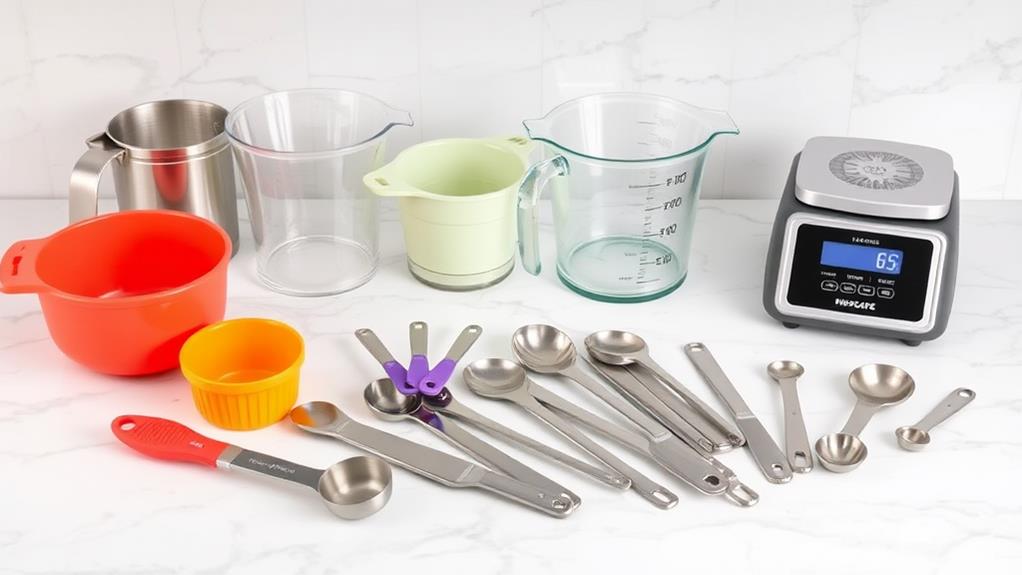
While dry and liquid measuring cups are staples in most kitchens, they're not the only tools at your disposal for accurate measurements. Digital kitchen scales have become increasingly popular for their precision, allowing you to measure both wet and dry ingredients with greater accuracy than traditional cups.
When dealing with sticky ingredients, you've got options beyond standard wet measuring cups. Consider these alternatives:
- Grease your liquid measuring cup for easier pouring and less waste.
- Use measuring spoons for small quantities to avoid mess.
- Opt for a digital scale to measure by weight instead of volume.
Measuring spoons are versatile tools that work well for both liquid and dry ingredients in small amounts. They're especially useful when you need precise measurements for spices or extracts.
Frequently Asked Questions
Is 1 Cup Dry the Same as 1 Cup Wet?
No, 1 cup dry isn't the same as 1 cup wet. You'll find that dry and liquid ingredients have different densities and measuring methods. When you're using dry measuring cups, you'll level off the ingredients, while liquid cups account for the meniscus. For example, 1 cup of flour weighs about 4.5 ounces, but 1 cup of water weighs 8 ounces. It's essential to use the right type of measuring cup for each ingredient to guarantee your recipes turn out correctly.
Is 16 Oz Dry the Same as 16 Oz Liquid?
Time to clear the fog on this measurement mystery! No, 16 oz dry isn't the same as 16 oz liquid. You're dealing with two different measurements here. Dry ounces measure weight, while fluid ounces measure volume. They're not interchangeable. For example, 16 oz of flour won't fill the same space as 16 fl oz of water. The density of the ingredient plays a vital role in this difference. Always check your recipe to see if it specifies dry or liquid measurements for accuracy.
How Much Is 1 Cup of Water in a Dry Measuring Cup?
When you measure 1 cup of water in a dry measuring cup, you'll still get 8 fluid ounces. However, it's not the best method. You'll need to be careful not to overfill or spill, as dry cups don't have a spout for easy pouring. While it's possible to use a dry cup, you'll get more accurate results with a liquid measuring cup. Remember, both types measure volume, but liquid cups are designed for precise meniscus readings.
How Do You Convert a Wet Measuring Cup to Dry?
You'd need superhuman powers to truly convert a wet measuring cup to dry! In reality, you can't directly convert them. Instead, use the appropriate cup for each ingredient type. For dry ingredients, use a dry measuring cup and level off the top. For liquids, use a wet measuring cup and fill to the meniscus line. Remember, 1 cup of liquid equals 8 fluid ounces, but for dry ingredients, it's better to measure by weight. Always use the right tool for accurate measurements.





